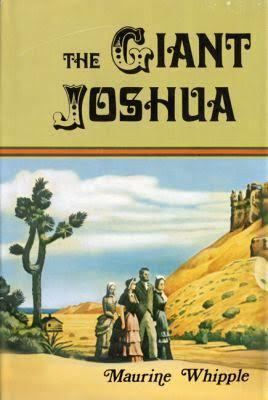7.4 /10 1 Votes7.4
Originally published 1941 | 3.7/5 Goodreads | |||||||||||||||||||||||||||||||||
 | ||||||||||||||||||||||||||||||||||
The Giant Joshua is a 1942 novel written by Maurine Whipple about polygamy in nineteenth-century Utahn Dixie. It is the first (and only written volume) of a proposed trilogy on the "Mormon Idea."
Contents
Plot, characters, themes
Among the many real characters such as Brigham Young, John D. Lee, and Erastus Snow, The Giant Joshua focuses primarily on Abijah MacIntyre and his wives, Bathsheba, Willie, and Clorinda.
The move to southern Utah where they are prominent members of the communities of Washington, Santa Clara and St. George during their founding years.
The novel engages with both the damages caused by Mormon polygamy and the Idea:
Expectations, reception, legacy
Houghton Mifflin awarded Whipple the Houghton Mifflin Literary Prize in 1938 for the novel's concept, which earned her $1000 to work on the novel, arranged for her to work at Yaddo, and paid her an advance of $50 per each completed chapter. Houghton anticipated that the book would be promoted by The Church of Jesus Christ of Latter-day Saints (LDS Church) and thus enjoy huge sales in the American West (Whipple did not agree), as well as being a bestseller generally.
The novel was widely and positively reviewed nationally, but sales did not match expectations (perhaps in part because of World War II), and the book received a harsh reception from Mormons who tended to find it antagonistic. The only response to the book in an official Church publication was from John A. Widtsoe who felt it treated the spiritual drive behind polygamy fairly, but that the novel misrepresented the results.
Emma Ray McKay said she was "so disgusted with the author of “The Giant Joshua” that I can scarcely contain myself. The outside people or rather nonmembers of our church do not understand our life during polygamous days and personal experiences of this kind should never be given to them. The publishers must always have something disgusting to tell even if they have to add something themselves."
Whipple believed that the Church even prevented Utah bookstores from stocking the book even when A St. George was experiencing over 500 requests per week.
In the 1970s, with the growth of Mormons arts and criticism, The Giant Joshua enjoyed a resurgence, including a 1976 republication in hardback and attention from scholars.
Shortly before her death, Whipple was honored with a lifetime achievement award from the Association for Mormon Letters and which added substance to her longheld belief that Mormons would eventually recognize the worth of her work.
Today The Giant Joshua is frequently cited on proposed lists of "Great Mormon Novels." Eugene England, for instance, described The Giant Joshua as "not the great Mormon novel, but the greatest."
Trilogy and derivitave works
Whipple never finished a sequel to The Great Joshua. The novel was translated into French as Clory, femme de Mormon. Whipple received payment for the film rights in her lifetime, but no film was ever made. Sterling Van Wagenen, cofounder of the Sundance Film Festival, often spoke of his desire to adapt The Giant Joshua to film.
